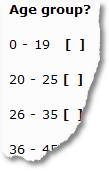
How different is a 6 year old from a 15 year old?
And how different is a 36 year old from a 45 year old?
You will probably agree with me that the difference in the first case is a lot more significant than that in the second.
So how come the 36 year old and 45 year old are likely to find themselves getting their own age brackets on many surveys (are you aged: 25 – 35?, 36 – 45?, 46 – 55? etc.) when the 6 year old and 15 year old will most likely find themelves lumped together a in the 0 – 19 bracket?
Ok. Here are some possible reasons:
.jpg) Reason #1: Relevance . We don't generally get 6 year olds to fill in surveys. And indeed, if your survey is about insurance product choice then I would suggest you're right to avoid burdening a child with questions about attitudes towards fiscal risk.
Reason #1: Relevance . We don't generally get 6 year olds to fill in surveys. And indeed, if your survey is about insurance product choice then I would suggest you're right to avoid burdening a child with questions about attitudes towards fiscal risk.
However – if you survey is about some relatively universal experience without a legal limit on who might be participating in it – like, for example, spending time in a community space, accessing the internet or feeling save (or not) crossing the road – then perhaps you should be including the 6 year old and certainly the 15 year old, in your survey.
Reason #2: Limited sample. We may suceed in surveying the 6 year old and the 15 year old, (and the 7 through 14 year olds) but we just don't manage to survey all that many of them compared to, for example, the number of 25 – 34 year olds we survey. So we put the 0 – 19 year olds together in a big category to give us a statistically significant group.
Reason #3: Skills. Carrying out a survey with children and young people can require specific skills and training that many researchers may lack.
Reason #4: Consent and ethics. There may be questions around the capacity of children and young people to give informed consent to taking part in a survey, and about whether the survey will raise questions on issues children should be protected from thinking about.
Do the reasons cut it?
Not really. Reason #1, 'Relevance', is important. It should tell us that as soon as a survey significantly covers issues that are relevant to young people they should be included in the survey data. Issues #2, 3 & 4 are ones we can and should work around.
Why does it matter?
Without including children and young people in the surveys and datasets being used by policy makers and practioners to make decisions on a day-to-day basis, we make children and young people 'statistically invisible'. And that can have a big (quite possibly very negative) impact on decisions made that affect children and young people's lives.

.jpg) Reason #1: Relevance . We don't generally get 6 year olds to fill in surveys. And indeed, if your survey is about insurance product choice then I would suggest you're right to avoid burdening a child with questions about attitudes towards fiscal risk.
Reason #1: Relevance . We don't generally get 6 year olds to fill in surveys. And indeed, if your survey is about insurance product choice then I would suggest you're right to avoid burdening a child with questions about attitudes towards fiscal risk.